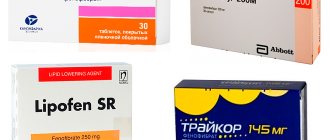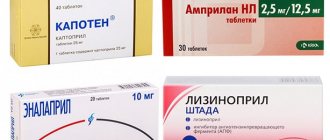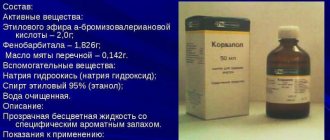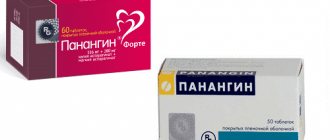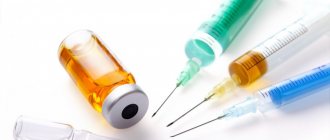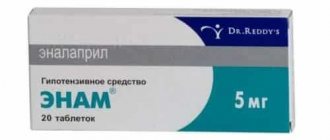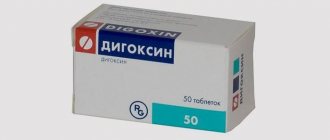Panangin is a drug (tablets) that corresponds to the group of mineral supplements. Important features of the medicine from the instructions for use:
How to dissolve vascular plaques, normalize blood circulation, blood pressure and forget the way to the pharmacy
- During pregnancy: with caution
- When breastfeeding: contraindicated
- In childhood: contraindicated
- If renal function is impaired: contraindicated
pharmachologic effect
What is the medicine for? This is a source of potassium and magnesium. The drug helps restore electrolyte balance, regulates metabolic reactions and processes, and has a pronounced antiarrhythmic effect. Potassium takes an active part in synaptic transmission, in the conduction of nerve impulses along fibers, in muscle contractions, and supports the normal functioning of the heart. When potassium metabolism is disturbed, the excitability of muscle tissue and nerves changes. Active ion transport maintains a high potassium gradient across the plasma membrane. Small dosages of potassium contribute to the expansion of the coronary arteries, and in large dosages the microelement narrows their lumen. Potassium has a moderate diuretic effect, negative bathmotropic and chronotropic effects. Magnesium is a cofactor in three hundred enzyme reactions. Magnesium is an essential element during processes and reactions that provide energy intake and expenditure. Magnesium is part of the pentose phosphate structure of DNA, takes part in the process of cell division and growth, the structure of heredity, and RNA synthesis; is a natural BMCA, prevents the release of free fatty acids and catecholamines under stress, and promotes the penetration of potassium ions into the cell. The drug has a stimulating effect on intercellular phosphate synthesis.
Mnn: potassium and magnesium aspartate.
Pharmacological group: potassium and magnesium preparation.
Contraindications
According to the instructions for use of “Panangin”, it is known that the use of the medication is prohibited for a number of specific conditions of the body, which include:
- Acute or chronic kidney disease.
- Hyperkalemia (a pathological condition that causes an abnormally high concentration of potassium in the blood).
- Hypermagnesemia (a pathological condition that manifests itself when the concentration of magnesium in the bloodstream increases).
- Addison's disease (damage to the thyroid gland, subsequently the adrenal glands lose the ability to produce the required amount of hormones, primarily cortisol).
- Atrioventricular block 2-3 degrees (a type of heart block, which is characterized by a violation of the electrical impulse from the atria to the ventricles).
- Myasthenia gravis (an autoimmune chronic progressive disease that traditionally begins with damage to the facial muscles, but muscle atrophy does not occur).
- Cardiogenic shock (extreme degree of left ventricular failure, characterized by a sharp decrease in myocardial contractility).
The use of tablets is also prohibited in cases of hemolysis, acute metabolic acidosis, and dehydration. How to drink Panangin correctly?
According to the instructions for use, the drug is used with extreme caution in “interesting situations.” The solution for intravenous administration is not recommended for administration if there is increased sensitivity to the substances in the solution.
In addition, the medicine is not used during breastfeeding, or for patients under the age of 18 years.
The solution is used with extreme caution in cases of first-degree atrioventricular block, kidney damage, and metabolic acidosis. Before using the medicine, you must make sure there are no restrictions. How many days should you take Panangin?
Indications for use of Panangin
Panangin tablets - what are they for?
Indications for use of Panangin are as follows. The drug is prescribed for hypomagnesemia, hypokalemia, when taking laxatives and diuretics, glucocorticosteroids, for diarrhea, persistent vomiting, taking saluretics, for myocardial infarction, heart failure, digitalis intoxication, ventricular extrasystole, atrial extrasystole, supraventricular tachycardia, paroxysmal tachycardia.
Example of a recipe in Latin: Rp.: Dragee “Panangin” N. 20
Panangin for prevention: how to take it correctly
Panangin is a drug (tablets) that corresponds to the group of mineral supplements. Important features of the medicine from the instructions for use:
How to dissolve vascular plaques, normalize blood circulation, blood pressure and forget the way to the pharmacy
- During pregnancy: with caution
- When breastfeeding: contraindicated
- In childhood: contraindicated
- If renal function is impaired: contraindicated
Composition of tablets
Active ingredients: magnesium aspartate (140 mg) and potassium aspartate (158 mg).
Additional substances: silicon dioxide, corn and potato starch, talc, povidone, magnesium stearate. The shell consists of talc, macrogol 6000, titanium dioxide, methacrylic acid copolymer.
Concentrate for solution (Panangin IV)
Contains magnesium aspartate (40 mg) and potassium aspartate (45.2 mg), as well as water for injection.
Release form
Available in tablet form and as a solution concentrate.
pharmachologic effect
What is the medicine for? This is a source of potassium and magnesium. The drug helps restore electrolyte balance, regulates metabolic reactions and processes, and has a pronounced antiarrhythmic effect.
Potassium takes an active part in synaptic transmission, in the conduction of nerve impulses along fibers, in muscle contractions, and supports the normal functioning of the heart. When potassium metabolism is disturbed, the excitability of muscle tissue and nerves changes.
Active ion transport maintains a high potassium gradient across the plasma membrane. Small dosages of potassium contribute to the expansion of the coronary arteries, and in large dosages the microelement narrows their lumen. Potassium has a moderate diuretic effect, negative bathmotropic and chronotropic effects.
Magnesium is a cofactor in three hundred enzyme reactions. Magnesium is an essential element during processes and reactions that provide energy intake and expenditure.
Magnesium is part of the pentose phosphate structure of DNA, takes part in the process of cell division and growth, the structure of heredity, and RNA synthesis; is a natural BMCA, prevents the release of free fatty acids and catecholamines during stress, and promotes the penetration of potassium ions into the cell. The drug has a stimulating effect on intercellular phosphate synthesis.
Mnn: potassium and magnesium aspartate.
Pharmacological group: potassium and magnesium preparation.
Pharmacodynamics and pharmacokinetics
The active substances play an important role in the formation of connections between macromolecules, as well as intracellular structures and the mechanism of muscle contraction and myocardial metabolism.
According to the annotation, the drug is well absorbed. Excreted through the kidneys.
Indications for use of Panangin
Panangin tablets - what are they for?
Indications for use of Panangin are as follows.
The drug is prescribed for hypomagnesemia, hypokalemia, when taking laxatives and diuretics, glucocorticosteroids, for diarrhea, persistent vomiting, taking saluretics, for myocardial infarction, heart failure, digitalis intoxication, ventricular extrasystole, atrial extrasystole, supraventricular tachycardia, paroxysmal tachycardia.
Example of a recipe in Latin: Rp.: Dragee “Panangin” N. 20
Contraindications for Panangin
The drug is not used for intolerance to fructose, sorbitol, impaired amino acid metabolism, chronic pathology of the renal system, hemolysis, exicosis, dehydration, arterial hypotension, myasthenia gravis, atrioventricular block, hypermagnesemia, hyperkalemia, metabolic acidosis, Addison's disease. Panangin is used with caution during pregnancy.
Side effects
Side effects are the following manifestations: ulceration of the mucous wall of the digestive tract, epigastric pain, diarrhea, bleeding from the organs of the digestive system, drop in blood pressure, bradycardia, paradoxical reaction in the form of an increase in the number of extrasystoles, dry mouth, nausea, flatulence, hyporeflexia, skin itching , dyspnea, thrombosis, phlebitis, paresthesia, dizziness, increased sweating, asthenia, myasthenia. With rapid intravenous infusion, hypermagnesemia and hyperkalemia are observed.
Panangin tablets, instructions for use
How to take the medicine? The drug is taken orally three times a day, 2 tablets. Maintenance and preventive therapy: 1 tablet three times a day, course for 3-4 weeks. In some situations, a repetition of the course of therapy is required.
Instructions for intravenous use
Panangin solution is injected intravenously, slowly. The drug is administered at a rate of 20-30 drops per minute, 1-2 times a day, 300 ml. Dosing of the drug Panangin during pregnancy is carried out according to the standard regimen of medication use.
Children can take the medicine from birth.
How to take Panangin for prevention?
If you ask the question of the benefits and harms of Panangin, you should realize that this is a drug that has its own side effects, so you should not use it for prevention.
Firstly, in this way you accustom the body to a high content of magnesium and potassium, and secondly, you can provoke an overabundance of these substances, which in turn can cause a lot of negative reactions.
Overdose
Manifested by muscle hypotonicity, hyperkalemia, slowing of atrioventricular conduction, cardiac arrest, arrhythmia, paresthesia of the limbs, changes in the electrocardiogram. An emergency intravenous infusion of a solution of dextrose and sodium chloride is required. If necessary, peritoneal dialysis and hemodialysis are justified.
Interaction
Panagin is able to enhance the negative bathmotropic and dromotropic effects of antiarrhythmic drugs. The medication eliminates hypokalemia, which develops against the background of long-term use of diuretics, glucocorticosteroids, and MCS.
NSAIDs, ACE inhibitors, heparin, potassium-sparing diuretics, cyclosporine, beta-blockers increase the risk of hyperkalemia. When using general anesthetics, the inhibitory effect of panangin on the nervous system increases. Succinyl chloride, decamethonium, atracuronium, suxamethonium enhance neuromuscular blockade.
The use of enveloping and astringent medications reduces the absorption of potassium and magnesium in the digestive tract. In combination with insulin, dextrose as part of a polarizing mixture, the heart rate is normalized in case of an overdose of cardiac glycosides, in case of ectopic arrhythmias, myocardial infarction.
Panangin improves the tolerability of cardiac glycosides and is pharmaceutically compatible with their solutions.
Storage conditions
Keep out of the reach of children at a temperature of 15-30 degrees Celsius.
Panangin's analogs
Substitutes can be considered such analogues of Panangin as Asparkam, Biolectra Magnesium Fortissimum, Potassium and Magnesium Asparaginate.
Alcohol compatibility
The drug is poorly compatible with alcohol, if only because the medicine is usually used for problems with the heart and vascular system, and alcohol in these cases should be excluded. However, that's not all. If these substances are used simultaneously, vasospasm may occur.
Reviews about Panangin
Reviews about Panangin on the forums are mostly positive. Buyers note the drug as really effective, the medicine makes the heart work easier, eliminates cramps, and really helps. Marked as a good pill for the heart.
Reviews of Panangin during pregnancy are as follows: the medication is often prescribed by doctors and is quite effective, despite the fact that the description of the drug recommends using the drug with caution during this period.
Panangina price
The price of Panangin in tablets is 130 rubles, the price in ampoules is 160 rubles.
How much do tablets cost in St. Petersburg? You can buy them for 125 rubles.
The price of Panangin is in Ukraine 120 and 130 UAH for tablets and solution, respectively.
How to take Panangin for preventive purposes?
The condition of the whole organism depends on the state of the myocardium, which is responsible for blood circulation. Mineral deficiency (in particular Mg and K) increases the risk of developing heart pathologies.
Panangin is part of the group of cardiac drugs that act on myocardial muscles.
How to take Panangin for prevention is decided by a specialist after an individual consultation and assessment of the clinical data obtained.
Characteristics of the drug
The drug Pentalgin belongs to the group of mineral complexes that restore the deficiency of magnesium and potassium.
The drug was developed to eliminate dysfunction of the myocardium and adjacent vessels that arise against the background of mineral deficiency.
The medication affects the functionality of the myocardium, preventing pathologies of the heart and blood vessels, as well as accelerating the healing process during complex therapy.
In case of cardiovascular abnormalities, the use of the drug should be carried out by taking tablets. The concentrated solution is used only for medicinal purposes.
In addition to the main components, the drug composition contains the following substances:
- colloidal silicon dioxide;
- povidone;
- magnesium stearate;
- titanium dioxide;
- methaclyric acid.
This drug affects the functions of the myocardial muscles, so its use is permissible only as prescribed by a cardiologist. For heart prevention, Panangin is used subject to strict adherence to the therapeutic regimen and if there are appropriate indications.
The derivative form of the drug is Panangin Forte. Taking Panangin Forte for prophylaxis is undesirable , since the medication contains a high dosage of active ingredients and is recommended only for therapeutic purposes.
When is prophylaxis with Panangin necessary?
Diseases of the heart and blood vessels require constant monitoring. In order to prevent serious complications that can be fraught with serious consequences and even death, cardiologists recommend drinking Panangin for prevention.
People who are predisposed to diseases of this nature and in old age are also prescribed a course of taking Panangin for prevention.
The cardiologist prescribes the drug for preventive purposes if the patient’s diagnosis reveals:
- age-related disorders of the circulatory system or heart;
- signs of cardiac ischemia;
- disorders that arose after myocardial infarction;
- myocardial decompensation syndrome;
- abnormal heart rhythm.
For prophylaxis in the pathological condition of the heart muscles, Panangin can be prescribed to people who have been exposed to negative factors, resulting in Mg and K deficiency. The risk group includes cardiology patients who:
- constantly experience intense physical activity;
- forced to follow a strict diet for a long time;
- suffered a complicated acute respiratory infection.
If the rules of use are followed, Panangin helps to quickly restore the lack of minerals on which the functioning of the heart, and, consequently, the whole body depends.
Contraindications
Despite the fact that Panangin is a complex of minerals, the recommendations contained in the annotation should not be neglected. Particular attention should be paid to the list of contraindications specified in the instructions.
Taking the drug for prophylaxis is contraindicated for the following indications:
- renal failure of any form;
- endocrine disorders of the adrenal glands;
- AV block (except 1st degree);
- excess levels of K and Mg in the blood;
- insufficiency of the left stomach in acute form;
- severe autoimmune neuromuscular disorder;
- critical dehydration.
The medicine is not prescribed if you are intolerant to any medicinal component, during pregnancy, breastfeeding, or under the age of 18.
Relative contraindications:
- heart block 1st degree;
- liver pathologies;
- deviations in the acid-base balance in the blood;
- uric acid diathesis;
- hypophosphatemia.
In pharmacies, Panangin is dispensed without providing a medical prescription. However, the free sale of the drug does not imply uncontrolled use of the medication. Before starting prophylaxis, you should familiarize yourself with the contraindications so as not to worsen the patient’s condition.
By-effect
Taking Panangin for preventive purposes should be done with caution due to the risk of side effects. A negative reaction of the body to the drug can be caused by the presence of contraindications, excess dosage, violation of the treatment regimen, or an individual reaction to a complex of constituent substances.
Source: https://zdorov108.ru/profilaktika/panangin-dlya-profilaktiki-kak-pravilno-prinimat
Side effects
Side effects are the following manifestations: ulceration of the mucous wall of the digestive tract, epigastric pain, diarrhea, bleeding from the organs of the digestive system, drop in blood pressure, bradycardia, paradoxical reaction in the form of an increase in the number of extrasystoles, dry mouth, nausea, flatulence, hyporeflexia, skin itching , dyspnea, thrombosis, phlebitis, paresthesia, dizziness, increased sweating, asthenia, myasthenia. With rapid intravenous infusion, hypermagnesemia and hyperkalemia are observed.
Taking panangin for prevention
A lack of potassium and magnesium in the body leads to the development of arrhythmia, the functioning of the heart muscles is disrupted, and blood pressure increases. For these reasons, panangin is prescribed for the treatment of heart and vascular diseases. This product contains microelements necessary for the body. It is important to know how to take Panangin correctly for prevention.
Key Points About Panangin
The product is produced in Hungary and has 2 dosage forms - tablets and ampoules. The active ingredients of the drug, which help with heart diseases, are potassium and magnesium. Excipients include:
- magnesium stearate;
- silica;
- starch;
- talc;
- povidone.
The tablet shell contains talc, macrogol 6000, titanium dioxide, methacrylic acid copolymer.
The product for preparing a solution inside a vein contains magnesium, potassium, and injection water. Panagin Forte tablets are also produced. They differ from the usual drug, with double the content of magnesium and potassium.
Properties of panangin
When potassium and magnesium levels in the body are low, this leads to various diseases. Metabolic disorders can be noticed in the myocardium, hypertension can develop, and plaques form in the coronary arteries. Panangin will help compensate for the lack of elements such as magnesium and potassium. If the physiological balance between magnesium and potassium is disturbed, the following may occur:
- contractility of the heart muscle will decrease;
- the rhythm of organ contractions will change;
- the toxic properties of cardiac glycosides will increase.
A heart attack is the root cause leading to death and loss of ability to work. Based on observations, those patients who died had magnesium ions 2 times less than people with a healthy heart.
Magnesium has an anti-ischemic effect on myocardial tissue cells. It can increase the flow of blood through the coronary vessels.
If there is a deficiency of potassium, a person may experience dangerous arrhythmias, the heart will not work properly, and a stroke is possible. Therefore, if you increase the dose of potassium intake per day, the threat of the formation and development of a stroke will decrease by 40%.
The active ingredients will also slow down the growth of atherosclerotic plaques and help reduce excessive blood viscosity, which will prevent blood clots from forming.
When is the drug prescribed?
Panagin is used for the following diseases and conditions of the patient.
- Hypokalemia.
- Heart attack.
- Hypomagnesemia.
- Cardiac inferiority.
- Diarrhea.
- Prolonged vomiting.
- Paroxysmal tachycardia.
- Intoxication.
- Supraventricular tachycardia.
Panangin is prescribed for use of glucocorticosteroid drugs, diuretics, and laxatives.
The drug will help close open heart defects in infants and strengthen their heart muscles. It is also prescribed to children to relieve seizures that are associated with a lack of potassium and magnesium.
Today, Panangin is quite often prescribed to people over 45 years of age.
- For patients with diabetes mellitus, to prevent complications in the organ.
- Patients who are losing weight drink laxatives and diuretics.
- Women who take hormonal contraceptives.
- For those who suffer from cramps and pain in the muscles of the calves.
- As a preventative measure for heart complications due to influenza and other infections.
- For people visiting baths and saunas.
Taking the drug
The use of panangin as a prophylaxis or for the treatment of heart and vascular diseases is carried out according to the instructions, or following the doctor’s instructions.
Often taken 3 times a day, 1-2 tablets at a time. It is recommended to drink it after eating food and take it with enough liquid.
When the drug penetrates into an acidic environment, its effectiveness decreases. The course of treatment is 1-3 months.
The use of the medicine can be carried out when tests are carried out for a lack of potassium and magnesium. Also, if the patient takes diuretics, which can flush these substances out of the body.
Panangin can be prescribed as a source of the required vitamins and minerals. The drug must be taken 2 times a day, 2 tablets. The course of prevention lasts a month.
If the patient has suffered from a cold, the flu, also in case of physical activity, or during diets with restricted food intake, the medicine is used 3 times a day, 2 tablets for 14 days.
For heart and vascular disease, you need to take the drug 3 times, 3 tablets per dose. This dose is the maximum, therefore it cannot be exceeded.
Side effects
While taking the drug, the following side effects may occur:
- nausea;
- diarrhea;
- pain in the abdomen;
- vomit;
- dry mouth;
- decreased blood pressure;
- vein thrombosis;
- phlebitis;
- itchy skin;
- bradycardia;
- dizziness;
- increased sweating.
If you quickly pour in a panangin solution, hypermagnesemia and hyperkalemia develop.
In case of an overdose of the drug, the patient experiences muscle hypotonicity, hyperkalemia, atrioventricular conduction slows down, arrest of the main organ, arrhythmia, paresthesia of the limbs, and abnormalities on the electrocardiogram. The patient needs to urgently inject a solution of dextrose and sodium chloride into the vein. If necessary, peritoneal dialysis and hemodialysis are performed.
The medicine belongs to a combination drug; it contains easily digestible substances necessary for the body, such as potassium and magnesium. To strengthen the heart muscle and improve its function, you should consult a specialist before use so as not to harm your health.
(7 4,00 of 5) Loading...
Source: https://SosudInfo.com/drugs/panangin-dlya-profilaktiki.html
Instructions for use of Panangin (Method and dosage)
Panangin tablets, instructions for use
How to take the medicine? The drug is taken orally three times a day, 2 tablets. Maintenance and preventive therapy: 1 tablet three times a day, course for 3-4 weeks. In some situations, a repetition of the course of therapy is required.
Instructions for intravenous use
Panangin solution is injected intravenously, slowly. The drug is administered at a rate of 20-30 drops per minute, 1-2 times a day, 300 ml. Dosing of the drug Panangin during pregnancy is carried out according to the standard regimen of medication use.
Children can take the medicine from birth.
How to take Panangin for prevention?
If you ask the question of the benefits and harms of Panangin, you should realize that this is a drug that has its own side effects, so you should not use it for prevention. Firstly, in this way you accustom the body to a high content of magnesium and potassium, and secondly, you can provoke an overabundance of these substances, which in turn can cause a lot of negative reactions.
At what point does potassium deficiency occur?
- Potassium deficiency may occur due to the oral use of diuretic drugs, which are known to remove useful substances such as potassium along with urine;
- During a disease such as hyperaldosteronism, the adrenal gland secretes many times more of the special hormone aldosterone than required, as a result of which the sodium-potassium balance changes;
- With the consequences of diabetes mellitus;
- For severe stomach upset;
- In addition, potassium deficiency occurs as a result of poor diet and lifestyle.
A lack of potassium leads to severe weakness, malaise, disruption of the heart and the occurrence of extrasystole.
Interaction
Panagin is able to enhance the negative bathmotropic and dromotropic effects of antiarrhythmic drugs. The medication eliminates hypokalemia, which develops against the background of long-term use of diuretics, glucocorticosteroids, and MCS. NSAIDs, ACE inhibitors, heparin, potassium-sparing diuretics, cyclosporine, beta-blockers increase the risk of hyperkalemia. When using general anesthetics, the inhibitory effect of panangin on the nervous system increases. Succinyl chloride, decamethonium, atracuronium, suxamethonium enhance neuromuscular blockade. The use of enveloping and astringent medications reduces the absorption of potassium and magnesium in the digestive tract. In combination with insulin, dextrose as part of a polarizing mixture, the heart rate is normalized in case of an overdose of cardiac glycosides, in case of ectopic arrhythmias, myocardial infarction. Panangin improves the tolerability of cardiac glycosides and is pharmaceutically compatible with their solutions.
Will Panangin help with arrhythmia, including atrial fibrillation?
Panangin restores the disturbed balance of electrolytes in the tissues of the heart muscle, which leads to normalization of signals from the sinus node
(the main source of rhythm) to the atria, and from them to the ventricles.
Myocardial cells become less susceptible to the influence of stress factors, the contraction rhythm slows down, and at the same time the volume of cardiac output increases.
This explains the effectiveness of Panangin in the prevention and treatment of arrhythmias that occur with an acceleration of the pulse rate:
- tachycardia;
- extrasystole;
- atrial and ventricular fibrillation.
Panangin is most effective for the treatment of atrial fibrillation of ventricular origin, including those associated with intoxication with cardiac glycosides. It is prescribed for the prevention of microelement imbalances in combination with the main antiarrhythmic drugs to strengthen the myocardium.
Rules for taking Panangin
Today we will discuss the rules for taking our expensive drug - Panangin. Let's look at the question - how to take it correctly, let's touch on the topic of hangover and the role of our medicine in this process.
There are sections that are also present in the instructions for this drug, located on my blog, this was done intentionally.
Everyone who reads this article can study the issue comprehensively, without gaps; those who want to read the instructions themselves can follow the link above, or find it in the site navigation, it is intuitively easy and understandable.
So, the beginning of the article is already under this line, happy reading and good health!
A lack of potassium and magnesium in the body leads to the development of arrhythmia, the functioning of the heart muscles is disrupted, and blood pressure increases. For these reasons, panangin is prescribed for the treatment of heart and vascular diseases. This product contains microelements necessary for the body. It is important to know how to take Panangin correctly for prevention.
Key points about the drug
The product is produced in Hungary and has 2 dosage forms - tablets and ampoules. The active ingredients of the drug, which help with heart diseases, are potassium and magnesium. Excipients include:
- magnesium stearate;
- silica;
- starch;
- talc;
- povidone.
The tablet shell contains talc, macrogol 6000, titanium dioxide, methacrylic acid copolymer.
The product for preparing a solution inside a vein contains magnesium, potassium, and injection water. Panagin Forte tablets are also produced. They differ from the usual drug, with double the content of magnesium and potassium.
Properties of the medicine
When potassium and magnesium levels in the body are low, this leads to various diseases. Metabolic disorders can be noticed in the myocardium, hypertension can develop, and plaques form in the coronary arteries. Panangin will help compensate for the lack of elements such as magnesium and potassium. If the physiological balance between magnesium and potassium is disturbed, the following may occur:
- contractility of the heart muscle will decrease;
- the rhythm of organ contractions will change;
- the toxic properties of cardiac glycosides will increase.
A heart attack is the root cause leading to death and loss of ability to work. Based on observations, those patients who died had magnesium ions 2 times less than people with a healthy heart.
Magnesium has an anti-ischemic effect on myocardial tissue cells. It can increase the flow of blood through the coronary vessels.
If there is a deficiency of potassium, a person may experience dangerous arrhythmias, the heart will not work properly, and a stroke is possible. Therefore, if you increase the dose of potassium intake per day, the threat of the formation and development of a stroke will decrease by 40%.
The active ingredients will also slow down the growth of atherosclerotic plaques and help reduce excessive blood viscosity, which will prevent blood clots from forming.
How does panangin work for hangovers?
The fact is that alcohol is a strong diuretic, i.e. diuretic. This is why you often want to go to the toilet during a feast with alcohol. As a result, too much magnesium and potassium are excreted from the body in the urine.
Thus, the next morning with a hangover, a severe deficiency of potassium and magnesium occurs in the body, especially the first element. At the same time, a lack of magnesium leads to saturation of the blood with calcium, which is washed out of the bones in excess. A lack of calcium in the skeletal system threatens such a serious disease as osteoporosis.
At the same time, an excess of calcium in the human body is the cause of obvious hangover symptoms, such as:
- nervous excitability,
- chills,
- muscle weakness,
- heart problems.
Thus, panangin (or its analogue Asparkam), replenishing the lack of these two important elements in the body, leads to the rapid elimination of the listed hangover symptoms.
By the way, this drug is an integral part of a home first aid kit for emergency drug treatment.
How to take Panangin for a hangover
To relieve hangover symptoms, it is enough to take 1-2 tablets of Panangin. However, in most cases, when the consequences of excessive alcohol intake are not very pronounced, it is better to get by with brine and other folk remedies, because Panangin has a number of contraindications for use, namely:
- diseases of the cardiovascular system,
- renal failure (acute and chronic),
- excess potassium and magnesium in the body,
- myasthenia gravis in severe forms.
In addition, the drug itself has side effects such as nausea, vomiting, headache, abdominal pain, etc.
It should also be borne in mind that panangin is effective for hangovers only as part of complex therapy for alcohol intoxication. This drug is not suitable as an emergency medicine or for self-use to eliminate unpleasant symptoms.
If you really can’t wait to take a pill, a much more effective remedy for relieving a hangover is Magnesol (the active substance is magnesium diasparkal), which can be used as an independent remedy for a not very severe hangover.



